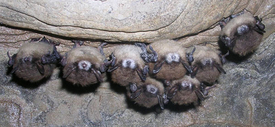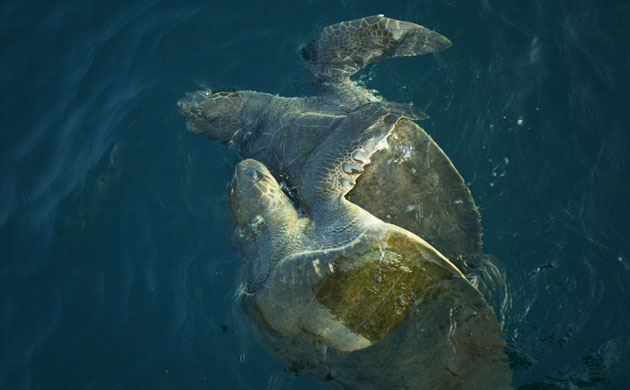TOP STORIES:
DEC Survey Shows Bat Populations Down 90 Percent in Caves Impacted  by "White Nose Syndrome"
by "White Nose Syndrome"
New York Department of Environmental Conservation - www.dec.ny.gov
16 December 2009
Photo credit: N Heaslip
Populations of some bat species have plummeted more than 90 percent in Northeast caves impacted by "White Nose Syndrome," according to an extensive investigation by the New York State Department of Environmental Conservation (DEC), Commissioner Pete Grannis announced today.
Surveying 23 caves at the epicenter of the bat die-off in early 2009, researchers found an alarming decline - 91 percent on average -- in the number of hibernating bats. The study included 18 caves in eastern New York, four in western Massachusetts and one in Vermont.
"These steep declines are alarming and disheartening," Commissioner Grannis said. "Researchers from around the country are focusing on the bat die-off and DEC will continue to work with a wide range of partners to try to get to the heart of the problem."
 Mammals May Be Nearly Half Way Toward Mass Extinction
Mammals May Be Nearly Half Way Toward Mass ExtinctionScience Daily - www.sciencedaily.com
18 December 2009
Photo credit: iStockphoto
If the planet is headed for another mass extinction like the previous five, each of which wiped out more than 75 percent of all species on the planet, then North American mammals are one-fifth to one-half the way there, according to a University of California, Berkeley, and Pennsylvania State University analysis.
Many scientists warn that the perfect storm of global warming and environmental degradation -- both the result of human activity is leading to a sixth mass extinction equal to the "Big Five" that have occurred over the past 450 million years, the last of which killed off the dinosaurs 68 million years ago.
Cited Journal Article
>>> N. America's biggest fish slips toward extinction
>>> Zoning the Ocean May Help Endangered Whales to Recover
Tackling a tiny terror of the sea

The Irish Times - www.irishtimes.com
17 December 2009
C O'Connell
Photo credit: Getty Images, E Cunningham, P Rojas/UCD
A UCD team has had some promising results in the search for a vaccine against sea louse, a parasite that has plagued Irish salmon farms and is threatening wild stocks
The animal glowing blue in the picture ... might look pretty, yet its effects are anything but. It’s a sea louse that attaches to salmon and causes damage to skin and scales, along with a general decline in the fish’s health.
The not-so-pretty parasite is a major problem for fish farmers and could potentially spread to wild populations, which is why researchers at University College Dublin are looking for an effective vaccine to help fish fend off the unwelcome hitchhikers.
 Beaches may be reservoirs of E.coli
Beaches may be reservoirs of E.coliUnited Press International, Inc. - www.upi.com
17 December 2009
Photo credit: I Mohamad/UPI
Beaches may be a reservoir of the pathogen E.coli as a result of migratory bird droppings, researchers in France and Portugal say.
Scientists at the Hopital de Bicetre in Paris and Universidade do Porto in Portugal said E.coli can be very resistant to antibiotic drugs, which makes the infection hard to treat.
The researchers found the same bacteria in the bird droppings as hospitalized people and concluded that people were getting infected by bird droppings on the sand on the beaches in Portugal.
TOP READ LINKS FROM LAST WEEK
News
- Federal Court Rules Massive Wind Energy Project in Violation of Endangered Species Act [bats]
- Gray wolf population declining in Yellowstone
- New York monkey meat smuggling case ends with probation
- Species on climate change hit list named [press release]
- They discovered chytrid fungus in frogs from Panama [translated by Google]
- Update on White-Nose Syndrome - NWHC Wildlife Health Bulletin [free full-text pdf available]
- Evolution of a transdisciplinary “One Medicine–One Health” approach to global health education at the University of California, Davis
- Lead Poisoning in Wild Birds - NWHC Fact Sheet [free full-text pdf available]
OTHER WILDLIFE HEALTH RELATED NEWS
Photo credit: STR/EPA
- The week in wildlife [image gallery]

- Fleming involved in study [leptospirosis]
- Headwater Stream Nutrient Enrichment Disrupts Food Web, Study Finds [cited journal article]
- Cyprus no man`s land a haven for rare wildlife
- Bird adopted in Hernando County after Animal Haus rescue tests positive for bacteria [Hernando County, Florida, USA - Map It
 ]
] - Wanted dead or alive: Christmas tree frogs
Climate Change News
- Acid oceans: the 'evil twin' of climate change
- New Report Underlines Multiple Benefits but Also New Challenges to Biodiversity-Rich Sites [cited journal article]
It Ain't All Bad News
- Rare Footage of the Rarest Ape [includes video, 1:22]
Huh, That's Interesting!




